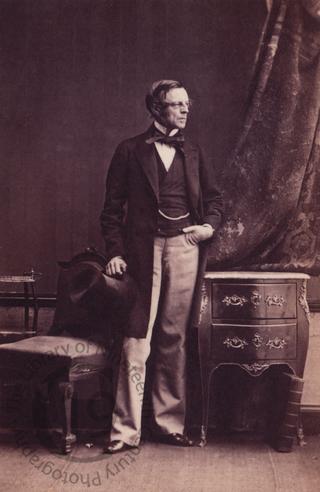
Lord Clermont
A carte-de-visite portrait of the Irish Whig politician Thomas Fortescue (1815-1887), created 1st Baron Clermont in 1852.
Born on 9 March 1815, Fortescue was the son of Chichester Fortescue, of Dromisken, County Louth, by Martha Angel, daughter of Samuel Meade Hobson, a barrister, of Muchridge House, County Cork. He was educated at Exeter College, Oxford. In 1833 he succeeded to the Ravensdale Park estate in Derbyshire on the death of Sir Henry James Goodricke, 7th Baronet, son of Sir Henry Goodricke, 6th Baronet, by Charlotte, sister of the first Earl of Clermont.
Fortescue was High Sheriff of Louth in 1839. In 1840 he was returned to parliament as one of two representatives for County Louth, a seat he held until the following year. In 1852 he was raised to the Peerage of Ireland as Baron Clermont, of Dromisken in the County of Louth, a revival of the Clermont title held by his kinsman. The peerage was created with special remainder to his younger brother, Chichester. In 1866 he was also created Baron Clermont, of Clermont Park in the County of Louth, in the Peerage of the United Kingdom, which entitled him to an automatic seat in the House of Lords. This peerage was created with normal remainder to his male heirs.
Lord Clermont married Lady Louisa Grace, daughter of James Butler, 1st Marquess of Ormonde, in 1840. There were no children from the marriage. He died at Ravensdale Park on 29 July 1887, aged 72. The English peerage became extinct on his death while he was succeeded in the Irish peerage according to the special remainder by his brother Chichester, who had already been elevated to the peerage in his own right as Baron Carlingford. Lady Clermont died at Ravensdale Park in November 1896, aged 80.
Photographed by Camille Silvy of London on 18 June 1861.
Code: 124757




